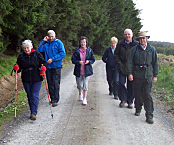 Walkers
battle against the wind Walkers
battle against the wind
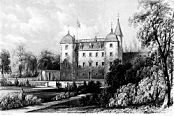
Darn Hall, to become Barony Castle
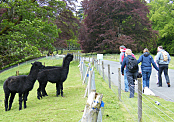
Alpacas in the grounds of Barony Castle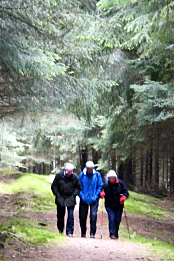
Shelter from the wind, through the trees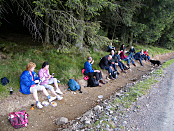
Lunch in the lee of Ewe Hill 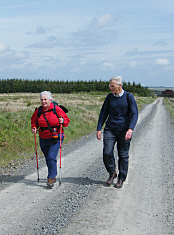
Stiff breeze along open section of road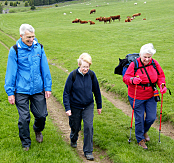
Good, the cows are not after us!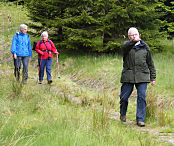 "This way" points Ian Dickson "This way" points Ian Dickson |
| | | Sponsored Walk 26
May 2011 |
Report by Jim Paterson
Photos Jim Paterson and Dorothy Paterson
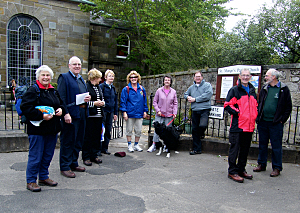 The
weather forecast for Saturday was dire looking indeed.The walkers were
busy digging out their waterproofs as it looked as if it was going to
be a wet one! Ian Dickson, obviously a boy scout in his
younger years, had pulled together a Plan B route
that offered
more shelter from the wind and rain, just in case. The
weather forecast for Saturday was dire looking indeed.The walkers were
busy digging out their waterproofs as it looked as if it was going to
be a wet one! Ian Dickson, obviously a boy scout in his
younger years, had pulled together a Plan B route
that offered
more shelter from the wind and rain, just in case.
However
Plan B was never
used, as the sun shone on our band of walkers as they arrived at the
front of St. Mungo's Church on the Saturday morning. The wind was what
pilots call a "stiff breeze" which means hold on to your seat it's a
blustery gale out there and its going to be bumpy.
We
headed down to Eddleston village, where we parked up and headed up the
road to the Black Barony. Built in 1536, this stunning manor
house, now a luxurious hotel and conferencing venue, is set in 25 acres of woodland.
Believed to have been commissioned by Sir Andrew Murray, it was
initially built as a border tower. It later served as a family home for
many years for the Murrays, an influential family in Scottish history.
Originally known as Darn Hall, it is sometimes also referred to as
Black Barony Castle. There are many curious stories of hauntings within
its walls, and since it has been a hotel so many guests have reported
strange goings on that a form is now left in each room for guests to
fill in if they happen to experience anything out of the ordinary.
Before
reaching the Castle we turned off past the Ice House, where ice for the
"Gin & Tonics" no doubt was kept before the arrival of the
refrigerator. Heading through the castle grounds we walked north toward
Shiplaw, joining the Shiplaw to Lamancha road for a time. We passed the
now disused Edinburgh University Observatory, built at the
time in one of the darkest spots in Midlothian, ideal for searching the
night skies. In fact I am told the well known Sir Patrick Moore visited
the Observatory, but that was many moons ago (if you forgive the pun!)
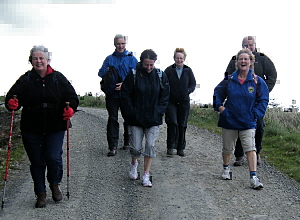 By now
we were heading into the Cloich Hills and the hamlet of Cloich itself.
The "stiff breeze" was fair ripping at our faces, and Bob Jarmson was
starting to look decidedly "weather beaten". We all prayed that demise
of the blue sky and the gathering grey clouds would keep moving swiftly
across our heads and refrain from pouring down on us. Apart from a spot
or two we made it to the lee side of Ewe Hill where we stopped to
shelter from the wind and grab some lunch, catching up with the young
hares who were a might quicker than the less sprightly among us. By now
we were heading into the Cloich Hills and the hamlet of Cloich itself.
The "stiff breeze" was fair ripping at our faces, and Bob Jarmson was
starting to look decidedly "weather beaten". We all prayed that demise
of the blue sky and the gathering grey clouds would keep moving swiftly
across our heads and refrain from pouring down on us. Apart from a spot
or two we made it to the lee side of Ewe Hill where we stopped to
shelter from the wind and grab some lunch, catching up with the young
hares who were a might quicker than the less sprightly among us.
Now
lunch is not a quick sandwich and a gulp of water when you walk with
Dorothy and Marjorie. The wine glasses appear, to be filled with a vintage red, brought in a coke bottle! The
main course is followed by cheese and biscuits. As Dorothy said "If your
going to do it, do it in style!"
Fully refreshed,
some of us more than others, we continued on our way. Leaving the lee
side of the Ewe hill brought us once more into the full force of the
"stiff breeze" which as you see above, made us laugh. Tree felling was in
progress and much of the hillside was cleared, removing what shelter
from the wind we expected, but it wasn't long before we headed into the
woods at Greenside, or Courhope, depending on what your map says, and
around Crailzie Hill, to meet up with the Border Drovers way.
But
not before we passed through a field of cows. Dorothy has bad memories
of cows, having had curious calves approach and pin her to a wall. This
field had full grown cows, and they became curious as well, but
fortunately not enough to approach and pin us to a wall.
Through
the gate we were safely on to the Border Drovers Way, which from the
16th to the mid 19th century was the main drove road between the trysts
(fairs) at Falkirk and Crieff, and the main meat market in London. The
black Kyloe cattle were prized in London, which, in the mid 18th
century, had a population of over 1 million, as against Glasgow
Aberdeen and Dundee at less than 12000. At the peak over 100,000 cattle
were walked south each year, at least equal to the sheep walked south
each year for mutton and wool.
We were
now heading back to Eddleston on the final leg of our walk, downhill
toward the Fairdean Burn and Barony Castle. We arrived back at the cars to
see the "hares" enjoying a rest on the park benches.
We
had made it and were still dry. A quick refreshment halt at the
Leadburn Inn gave us the opportunity to chat over a great day
which we all enjoyed, and managed to raise funds for St. Mungo's at the
same time from our sponsors..
| |